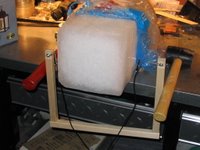The 15V power supply didn't work out, apparently due to some kind of current limiting circuit, so I cracked apart the 18V wall wart to find that a fuse had, in fact, blown. Deciding that a variable power supply was required, I built a simple one from a triac dimmer switch, the transformer from the busted 18V unit, and a fuse. This AC power supply works like a charm.
 Subsequent experiments with steel wires revealed significant inadequacies. One problem was that flakes of some dark material (I assume an iron oxide) sputtered off, deteriorating the wires. Another problem was that the cool parts of the wire in contact with ice didn't heat back up enough to cut at a reasonable speed. Steel's relatively high temperature coefficient of resistance prevented the cold parts of the wire from producing very much heat. Fortunately, the nichrome wire performed better, and it didn't break unless I turned up the power supply higher than necessary.
Subsequent experiments with steel wires revealed significant inadequacies. One problem was that flakes of some dark material (I assume an iron oxide) sputtered off, deteriorating the wires. Another problem was that the cool parts of the wire in contact with ice didn't heat back up enough to cut at a reasonable speed. Steel's relatively high temperature coefficient of resistance prevented the cold parts of the wire from producing very much heat. Fortunately, the nichrome wire performed better, and it didn't break unless I turned up the power supply higher than necessary.
 With a little downward force provided by gravity, the nichrome cutter was able to slowly but easily slice through a 10 pound block of supermarket ice (about 6.5" thick). I didn't time it properly, but I think it took about a minute to penetrate the entire thickness of the ice block. A very small amount of refreezing took place in a couple spots, just enough to keep the slab from falling to the floor.
With a little downward force provided by gravity, the nichrome cutter was able to slowly but easily slice through a 10 pound block of supermarket ice (about 6.5" thick). I didn't time it properly, but I think it took about a minute to penetrate the entire thickness of the ice block. A very small amount of refreezing took place in a couple spots, just enough to keep the slab from falling to the floor.
 I was able to remove the slab cleanly with a whack from a rubber mallet. Hitting the ice with a mallet wouldn't be a good idea at very cold temperatures, but the refrozen bits could probably be broken safely with a stronger, cold wire. Maybe refreezing could be completely avoided by using a hotter or thicker hot wire or by passing something (teflon strip? cold wire? another hot wire?) directly behind the hot wire.
I was able to remove the slab cleanly with a whack from a rubber mallet. Hitting the ice with a mallet wouldn't be a good idea at very cold temperatures, but the refrozen bits could probably be broken safely with a stronger, cold wire. Maybe refreezing could be completely avoided by using a hotter or thicker hot wire or by passing something (teflon strip? cold wire? another hot wire?) directly behind the hot wire.
 Gravity turned out to be a poor guide. If we were to use this technique for slab cutting, I guess we would need rails to guide the wire terminals.
Gravity turned out to be a poor guide. If we were to use this technique for slab cutting, I guess we would need rails to guide the wire terminals.
 Using the nichrome cutter, I carved a freehand trifle for Emily out of the small slab. Due to small inconsistencies in the perpendicularity of the cuts, I wasn't able to completely remove the carved piece from the slab without breaking something. For this kind of work, a stationary wire design would be better. I'll have to experiment with increased wire tension.
Using the nichrome cutter, I carved a freehand trifle for Emily out of the small slab. Due to small inconsistencies in the perpendicularity of the cuts, I wasn't able to completely remove the carved piece from the slab without breaking something. For this kind of work, a stationary wire design would be better. I'll have to experiment with increased wire tension.
Hot wire cutting is clearly a valuable ice carving technique. While certainly not supplanting the chainsaw or die grinder, the hot wire is able to make precise cuts not possible with the more traditional tools. Although my first design was a hand-held tool for freehand cutting, I think that a stationary, vertical wire would be more useful for detail work. I also think that a slab cutter employing a long wire could be practical.
I'm still concerned about:
- electrical safety: longer wires require higher voltage
- cutting speed: it is very slow, although slab cutting doesn't need to be fast
- refreezing: after cutting the supermarket block, I'm feeling more confident about this one
- wire breakage: I'd like to try thicker nichrome and possibly other materials
- ice cracking: we'll have to test this at cold temperatures






1 comment:
Cuando comencé a trabajar como asistente virtual, me costaba llevar un control claro de mis horarios, sobre todo al cambiar de clientes. Fue en ese contexto que conocí https://calculadoradedias.com/, y desde entonces no he dejado de usarla. Me encanta lo fácil que es ingresar las horas de entrada y salida, incluir descansos, y ver el total de horas facturables por jornada. Me ayuda a ser más profesional con mis entregas.
Post a Comment